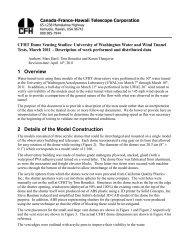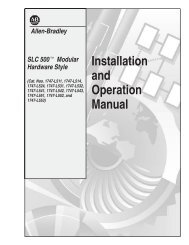Documentation [PDF] - Canada France Hawaii Telescope ...
Documentation [PDF] - Canada France Hawaii Telescope ...
Documentation [PDF] - Canada France Hawaii Telescope ...
Create successful ePaper yourself
Turn your PDF publications into a flip-book with our unique Google optimized e-Paper software.
accurately reflect the integration time per pixel because most COSMOS images are shifted by 30 ′ and<br />
only fill one quadrant of the CFHTLS u ∗ -band stack. The D2-u ∗ corresponds to the innermost regions of<br />
Fig. 46, delimited by the black contours. Table 23 describes each sub-field in more detail).<br />
5.2 Astrometric accuracy<br />
The astrometric accuracy is derived in the same way as for the Wide survey. We refer to the beginning of<br />
Section 4.5 for a description of the method. The Deep analysis is however simpler than the Wide because<br />
there is only one single position per field. The astrometric calibration of the Deep fields is detailed in<br />
Section 3.5, so we only focus on the accuracy in this section.<br />
The results of the internal and external error analysis are given in Tables 18 and 19. The internal errors<br />
have been measured by SCAMP, from the astrometric solutions of each Deep field, for each filter separately.<br />
In contrast, the external errors quoted in Tables 18 and 19 are not the values derived from the<br />
astrometric solutions. They are computed separately as well, but after the production of the Deep images,<br />
in order to get the true astrometric errors of sources in each stack. The reference external catalogue is<br />
2MASS, and the external errors found are very similar to the Wide survey.<br />
On average, the mean internal astrometric rms errors in the Deep fields are<br />
and the mean external errors<br />
σ RA = 0.056” ± 0.011” , and , σ DEC = 0.056 ± 0.011” , (17)<br />
σ RA = 0.283” ± 0.017” , and , σ DEC = 0.232 ± 0.014” , (18)<br />
where, the dispersions are the rms errors. Since the four fields are calibrated independently, the values<br />
quoted above are only rough estimates; the errors for D1, D2, D3 and D4 are given in Tables 18 and<br />
19. The rather large scatter in the internal errors is due to the different ways each Deep field has been<br />
calibrated (either using an internal catalogue based on the i band data, or using the external 2MASS<br />
catalogue, see Section 3.5). The external astrometric errors are similar to the Wide survey and correspond<br />
to the expectations, considering the astrometric errors in the 2MASS reference catalogue.<br />
5.3 Photometric accuracy<br />
5.3.1 Comparison with SDSS-DR8<br />
The photometric calibration of the Deep survey fields is fully described in Section 3.7. We aim in this<br />
section at conducting an external comparison to the SDSS survey: wherever possible, magnitude offsets<br />
between common stars in the CFHTLS Deep and SDSS-DR8 have been measured. SDSS magnitudes are<br />
first converted to the MegaCam AB system using the MegaCam-SDSS color transformation equations<br />
presented in the section comparing the Wide to SDSS-DR8 (Section 4.4.3, Equation 13).<br />
The offsets are quoted in Tables 18 and 19 and in the synoptic table. Only fields D2 and D3 have sources<br />
in common with SDSS-DR8. The offsets are found to be similar to the means 〈∆ m=u ∗ ,g,r,i/y,z〉 (Table 11)<br />
or 〈δ m=u ∗ ,g,r,i/y,z〉 (Table 6) found for the Wide fields.<br />
In both the Deep and the Wide surveys, the CFHTLS to SDSS-DR8 comparisons are made using stars<br />
with 17 < i < 21. The signal-to-noise ratio of all common stars on the Deep fields is much higher than<br />
for the Wide, hence it is reassuring to find very similar offsets in all filters for both the Deep and the<br />
70


![Documentation [PDF] - Canada France Hawaii Telescope ...](https://img.yumpu.com/26965302/82/500x640/documentation-pdf-canada-france-hawaii-telescope-.jpg)









